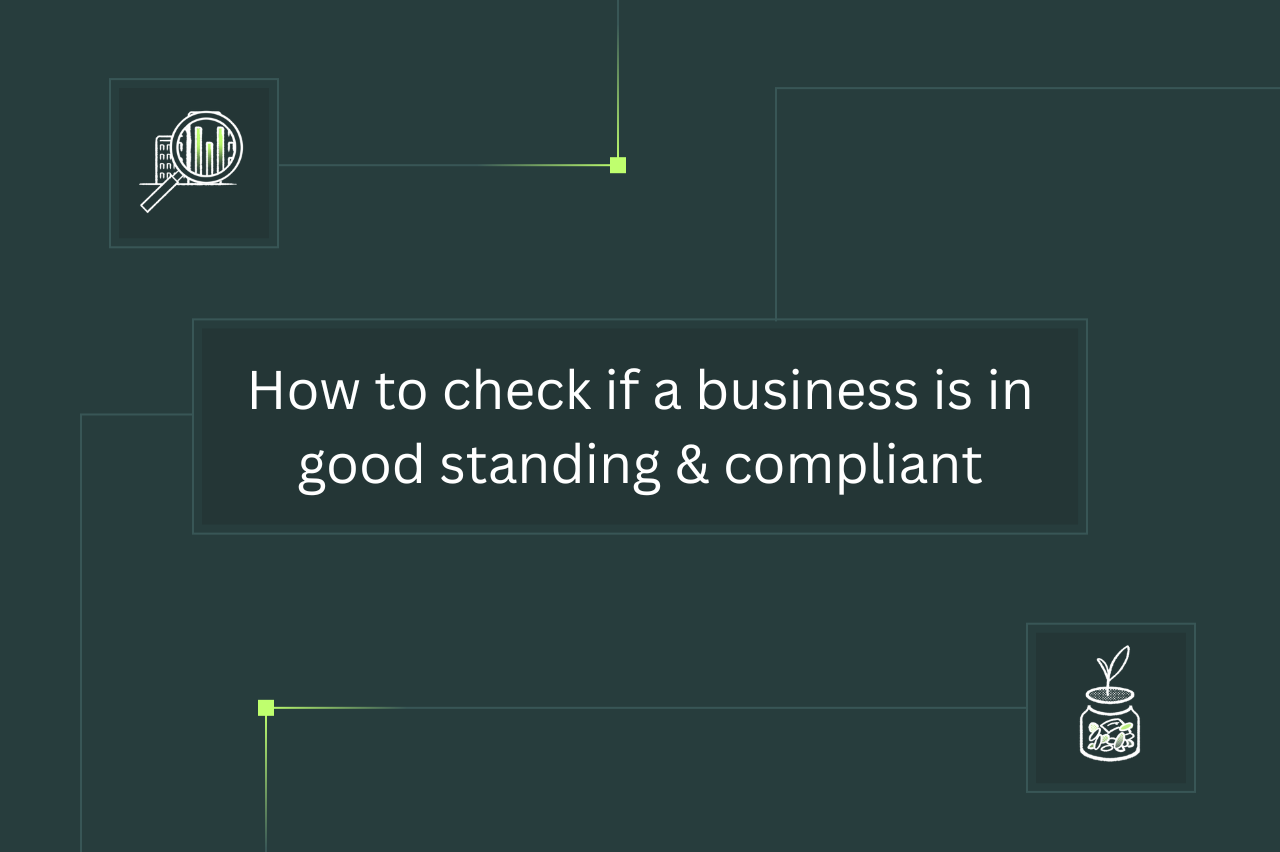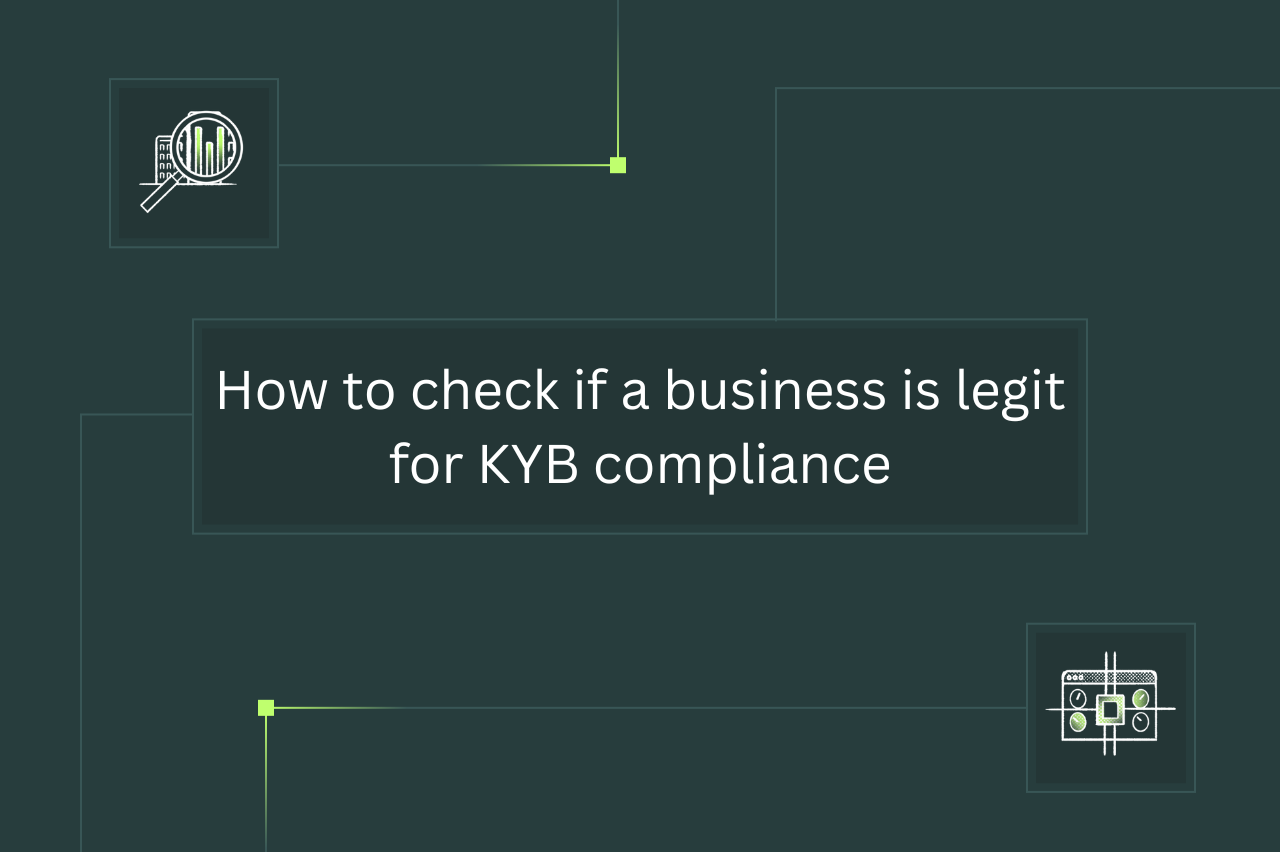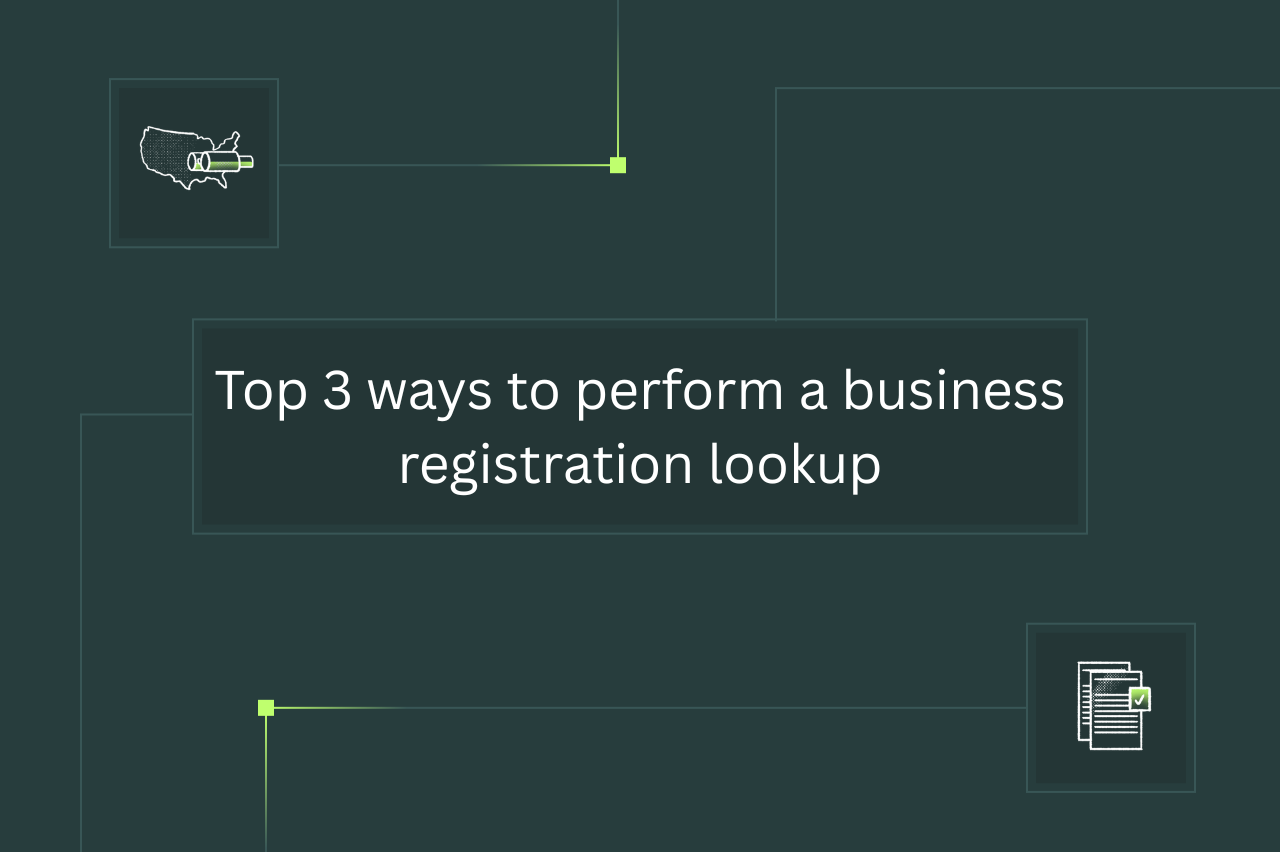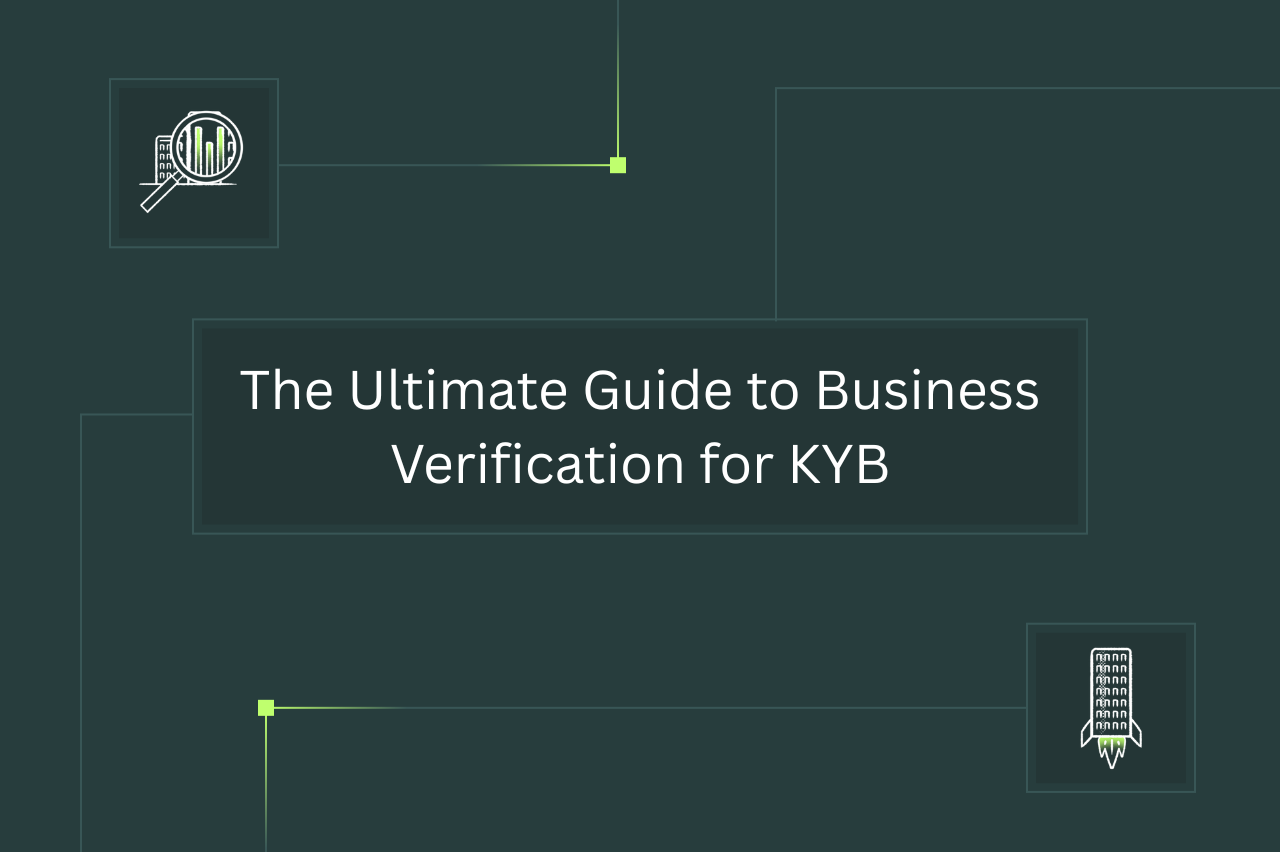In brief:
- A business being in good standing means it has met – and continues to maintain – all compliance and financial requirements (paperwork, fees, taxes, etc.) for staying legally registered to operate within a jurisdiction.
- Many types of institutions need to know whether or not a business is in good standing, as a business not in good standing carries risks such as fines, liens, loss of legal powers, or even being dissolved.
- A business could be in good standing but still carry other risk signals, such as bankruptcies, liens, politically exposed persons, or adverse media coverage; companies looking to onboard a business should look into these types of things as well.
A fundamental risk assessment question that you, as a company, should ask when onboarding another business is “Is this business properly registered to legally operate where it does?” While this seems like a simple question on the surface, maintaining proper registration status isn’t a one-and-done deal for a company. It has to regularly file paperwork with the appropriate authorities, pay administrative fees, and pay taxes – all without missing deadlines.
This is what it means when a business is said to be “in good standing”. In this article, we explain why being in good standing is important for a business – and why it can be important for you to know if you’re onboarding the business for business verification purposes. We also discuss how to see if a business is in good standing, including giving examples of other things you should know about a business before moving forward with a partnership.
- What is the meaning of “good standing” in business?
- Who needs to check if a company is in good standing?
- How to check if a business is in good standing
To start, we give a further explanation of what “good standing” means in a business context.
A business in good standing has properly registered with the relevant authorities and has kept up with its other related compliance and financial obligations. These include filing related paperwork on time, retaining paperwork as legally required, and paying filing fees and business taxes on time.
Larger business entities, such as corporations and LLCs, can apply for a document called a Certificate of Good Standing. This certifies that the business meets the above requirements and is legally allowed to conduct business in a particular state. It’s also sometimes called a Certificate of Status (or Status Certificate), Certificate of Existence, or Certificate of Authorization.
Why is a Secretary of State good standing important?
In the U.S., Secretary of State offices are responsible for maintaining registration of businesses operating within their respective jurisdictions. Being in good standing with the Secretary of State office in a state is one part of being legally allowed to conduct business within that state.
Potentially also relevant is being in good standing with the IRS, since it’s the primary tax administration agency in the U.S. This makes a business registration lookup vital for companies looking to ensure the companies they do business with are low-risk.
What does it mean if a business is not in good standing?
A company not in good standing has failed to meet one or more of its requirements for maintaining proper registration with the relevant authorities in a state. This is often caused by missing deadlines for filing paperwork, failing to pay filing fees on time, or not having a registered agent.
There are other situations in which a company can fall out of good standing, some of which are specific to individual state regulations. A business could become “not in good standing” in Illinois, for example, if it fails to pay the state’s franchise tax in a timely manner.
A company doesn’t necessarily need a Certificate of Good Standing to legally do business within a jurisdiction. However, many companies will get one anyway because it serves as a quick way to check if a business is legitimate and prove to other business parties that they are working with a good standing company.
Several kinds of entities need to know this information for various reasons.
- SoS offices in other states: Before a company expands its business into another state, it usually has to prove to the Secretary of State office there that it’s in good standing with the other states in which it conducts business.
- Banks and fintechs: Financial institutions (from traditional banks to fintechs) need to ensure companies are in good standing and properly registered as businesses before allowing them to open commercial bank accounts.
- Lenders: Checking if a business is in good standing allows lenders to see that the business doesn’t have a higher risk of defaulting due to fines and other unmet financial obligations.
- Insurers: Similar to lenders, insurers need to check whether a business is in good standing or not. The risks associated with a business not being in good standing can factor into how an insurer drafts a policy for that business, or whether they accept the business as a client at all.
- Payment Service Providers (PSPs): PSPs should also check that businesses that want to use their services are in good standing. After all, they don’t want to be complicit in funneling consumer money towards an illegitimate business.
{{related-content-block="/blog/how-to-check-if-a-business-is-legit"}}
If you want to check to see if a business is in good standing, there are a few ways you can do it. One is to check the Secretary of State office in a state where the business is operating. Another method that might work is to check the SEC’s EDGAR system (if the business is large enough to offer publicly-traded stocks). If all else fails, you can request a copy of the business’s Certificate of Good Standing directly from the business itself.
Remember that not all businesses will have a Certificate of Good Standing. One reason is that it’s not legally required to run a business (though, as we noted above, many types of other businesses will check for it before partnering with a company). Another is that, depending on individual state laws, certain types of businesses (such as sole proprietorships and limited partnerships) can’t get a Certificate of Good Standing – nor do they need one – because they aren’t required to register with Secretary of State offices.
Also remember that a business being in good standing simply means it’s keeping up with what it needs to do to remain officially registered as a business in a particular jurisdiction. But that’s far from the only indicator of whether or not a business may be risky to deal with.
There are several other signals that you’ll want to process in order to determine whether or not you should move forward with a partnership with another business. Here are a few worth noting.
1. See if a company filed for bankruptcy
A bankruptcy filing can allow a company to survive by getting out of some debts. However, it’s also a risk signal to potential business partners (like you!) and other creditors that the company may be less than reliable in repaying what it owes. It also may mean the company could soon lose assets to repay its creditors – ones that may be valuable to you, or helpful for the company to run its operations.
2. Find out if a business has a tax lien
Liens are legal claims to the assets of a person or business if they fail to pay back a debt on time. They can even be filed by U.S. state governments – or even the federal government – if a business gets behind on paying its taxes.
Federal/state tax liens on a business can usually be found at a Secretary of State office, since that’s where most business registration information is kept in the U.S. If they aren’t there, they may be in a state or county recorder’s office. You can also submit a FOIA request to the IRS and see if the primary tax administrator in the U.S. has records of liens.
Further information on how to find tax (and other kinds of) liens against a business can be found in our article on how to perform a business lien search.
3. Find out if there is a UCC filing against a company
A UCC is a specific type of lien filed in the U.S. against a person or business by a private creditor as part of a contract. In the case of businesses, it’s usually a lien on their property or other assets as collateral for a loan to be used towards office space, equipment, and so on.
UCC lien records can often be found where other liens are: at a Secretary of State office (try filing a UCC-11 form if you can’t find anything online) or at a state or county recorder’s office. Where they’re specifically kept, however, can depend on who the debtor is listed as (i.e. a business or one of its owners) and where they’re located, or where the collateral assets themselves are located.
{{related-content-block="/blog/ucc-lien-search"}}
4. Find and verify Articles of Incorporation
Articles of Incorporation are a class of business formation documents specific to corporations, proving a corporation was legally created and allowing it to operate legally within a jurisdiction (among other functions and benefits). They usually include information such as the corporation’s name, address, function, business structure, agents, directors, and so on.
Since businesses in the U.S. are registered at the state level, the most direct way to find out if a corporation has valid Articles of Incorporation on file is to check with a Secretary of State office. Be aware, however, that it’s not uncommon for a corporation to be formed in one state but operate primarily in another state.
We explain in further detail in our guide for how to find Articles of Incorporation.
5. Identify politically exposed persons & their risks
Politically exposed persons (PEPs) are people who hold (or held) influential public administrative positions in politics, law, business, military, finance, and so on. As such, they may have the means and opportunities to commit crimes that other kinds of people wouldn’t have.
This can also mean that they’re bigger targets for criminals to manipulate or threaten, and that crimes involving them can have greater impacts. Even Relatives and Close Associates (RCAs) to PEPs can carry the same kinds of risks.
After collecting and verifying information about people related to a company being onboarded (and their RCAs), check this information against several reputable sources for potential PEP statuses. If you find a match, assess how the person’s position might present risks (directly or indirectly) for your company.
You may decide to conduct Enhanced Due Diligence (EDD), a deeper dive into a person’s background. Typically, this traces how they’ve conducted their finances in the past, who else they have connections with, and where they’re getting their income and assets from.
When finished, document the whole process in a report. If you decide to stick with a client despite the potential PEP risks, be sure to develop an ongoing monitoring plan for relevant PEPs and RCAs to check for suspicious activities or potential increases in their risk profiles.
6. Search for negative news & adverse media
Adverse media is public information that portrays a business (or associated person) in a negative light. This could indirectly result in risk to you if you’re linked to that business. Examples include news stories, marketplace reviews, shared video footage, social network comments, and blog posts.
To screen for adverse media, start by collecting information about a business (and its owners) and verify it against official sources. Next, scan media sources using methods such as keyword-based techniques or AI-powered natural language processing. If you get a hit, assess its risk by looking at what happened, when it happened, how the business (or associated person) is related to it, and why it might represent risk. Finally, document the investigation and take any necessary further actions.
For a more thorough walkthrough of the process, see our guide on conducting adverse media screening for KYB.
{{gated-content-block="/insights/report-middesk-index"}}
While finding, verifying, and processing all of this information may seem like a daunting task, it doesn’t need to be. Middesk’s Business Verification solution puts much of what you need to know about a business for compliance purposes at your fingertips, and all you need is the business’s name and address.
Ask us for a demo with our team to see how we can help you ensure businesses you’re working with are legitimate and in good standing so you can accurately assess the risk of B2B relationships. If you want to see how we do it right away, check out our on-demand demo of Middesk Verify product:
{{gated-content-block="/events/productdemo-verify-june-2025"}}











